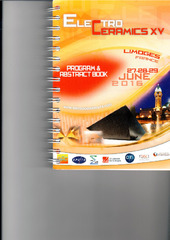Приказ основних података о документу
Microstructure and functional properties of solution-derived Sr-modified potassium sodium niobate thin films
| dc.creator | Vojisavljević, Katarina | |
| dc.creator | Kurinčič, Nika | |
| dc.creator | Uršič, Hana | |
| dc.creator | Malič, Barbara | |
| dc.date.accessioned | 2023-12-08T18:44:05Z | |
| dc.date.available | 2023-12-08T18:44:05Z | |
| dc.date.issued | 2015 | |
| dc.identifier.uri | http://rimsi.imsi.bg.ac.rs/handle/123456789/2897 | |
| dc.description.abstract | Over the past few decades, the potassium sodium niobate, K0.5Na0.5NbO3 (KNN) has drawn a lot of research interests as an environment-friendly lead-free ferroelectric material suitable for production of thin-film electronic devices. The poor functional properties of the KNN thin films prepared by chemical solution deposition are frequently addressed to the volatilisation of alkali (K- and Na-) compounds during processing, which hinders control over the stoichiometry, contributes to the formation of secondary phases and deterioration of the microstructure. The problem can be overcome by adding alkalis in excess and/or by partial substitution of the A- and B- site atoms, such as in the case of the solid state synthesized KNN ceramics. Therefore, in this contribution, the influence of the alkaline-earth A- site dopant, Sr2+ on the microstructure, structure, dielectric and ferroelectric properties were examined for the solution-derived KNN thin films with alkaline excess. Liquid precursors of (K0.5Na0.5)1-ySryNbO3 (KNN-ySr) thin-films, where the Sr- dopant content was set at y = 0, 0.005, 0.01, were prepared from potassium and sodium acetates and niobium ethoxide in 2-methoxyethanol solvent with 5 mol% of potassium acetate excess, and an appropriate amount of strontium acetate dissolved in acetic acid. The approximately 250 nm thick KNN-ySr thin films on Pt/TiOx/SiO2/Si substrates were obtained through repeated spin-coating and pyrolysis steps at 300 oC for 2 min, followed by the rapid thermal annealing at 650 oC in air flow for 5 min with heating and cooling rates of 12 K/s. According to X-ray diffraction analysis, all of the synthesized KNN thin films crystallize in pure perovskite phase with a random orientation. The surface and cross-section microstructure analysis, performed by the field emission scanning electron microscopy, reveals that the KNN-ySr films consist of equiaxed grains, the average size of which gradually decreases from about 90 nm to a few tens of nm by increasing the Sr-dopant content. In the contribution we report the influence of the chemical modification on the functional response of the as-prepared films, dielectric properties versus frequency and temperature, polarisation – electric field dependence and leakage current. In addition, the topography and the local current measurements of the KNN-ySr films analysed by atomic force microscopy are discussed. | sr |
| dc.language.iso | en | sr |
| dc.rights | openAccess | sr |
| dc.source | Electroceramics XV, June 27-28-29, 2015, Limoges, France | sr |
| dc.subject | K0.5Na0.5NbO3 | sr |
| dc.subject | thin films | sr |
| dc.subject | XRD | sr |
| dc.subject | SEM | sr |
| dc.subject | polarisatio-electric field dependence | sr |
| dc.title | Microstructure and functional properties of solution-derived Sr-modified potassium sodium niobate thin films | sr |
| dc.type | conferenceObject | sr |
| dc.rights.license | ARR | sr |
| dc.citation.epage | 164 | |
| dc.citation.spage | 164 | |
| dc.identifier.fulltext | http://rimsi.imsi.bg.ac.rs/bitstream/id/7610/bitstream_7610.pdf | |
| dc.identifier.rcub | https://hdl.handle.net/21.15107/rcub_rimsi_2897 | |
| dc.type.version | publishedVersion | sr |

